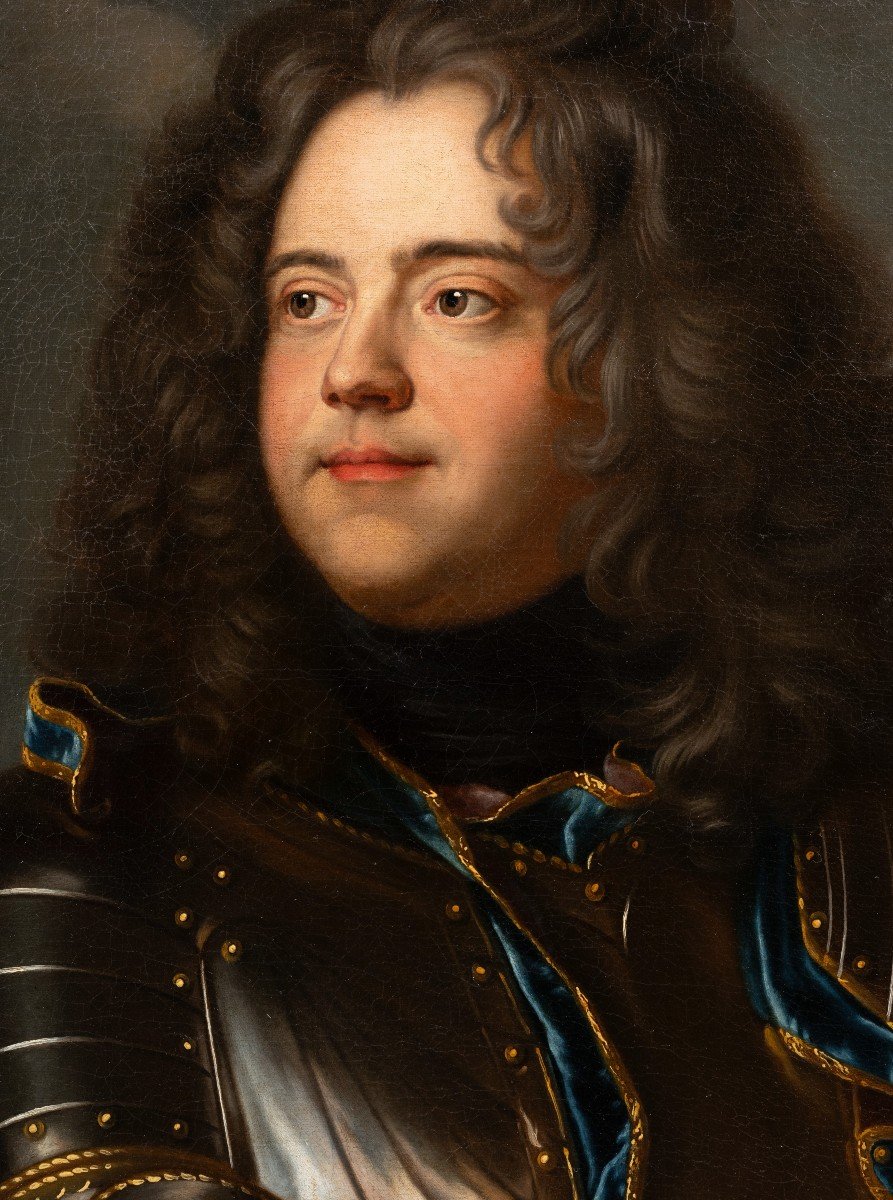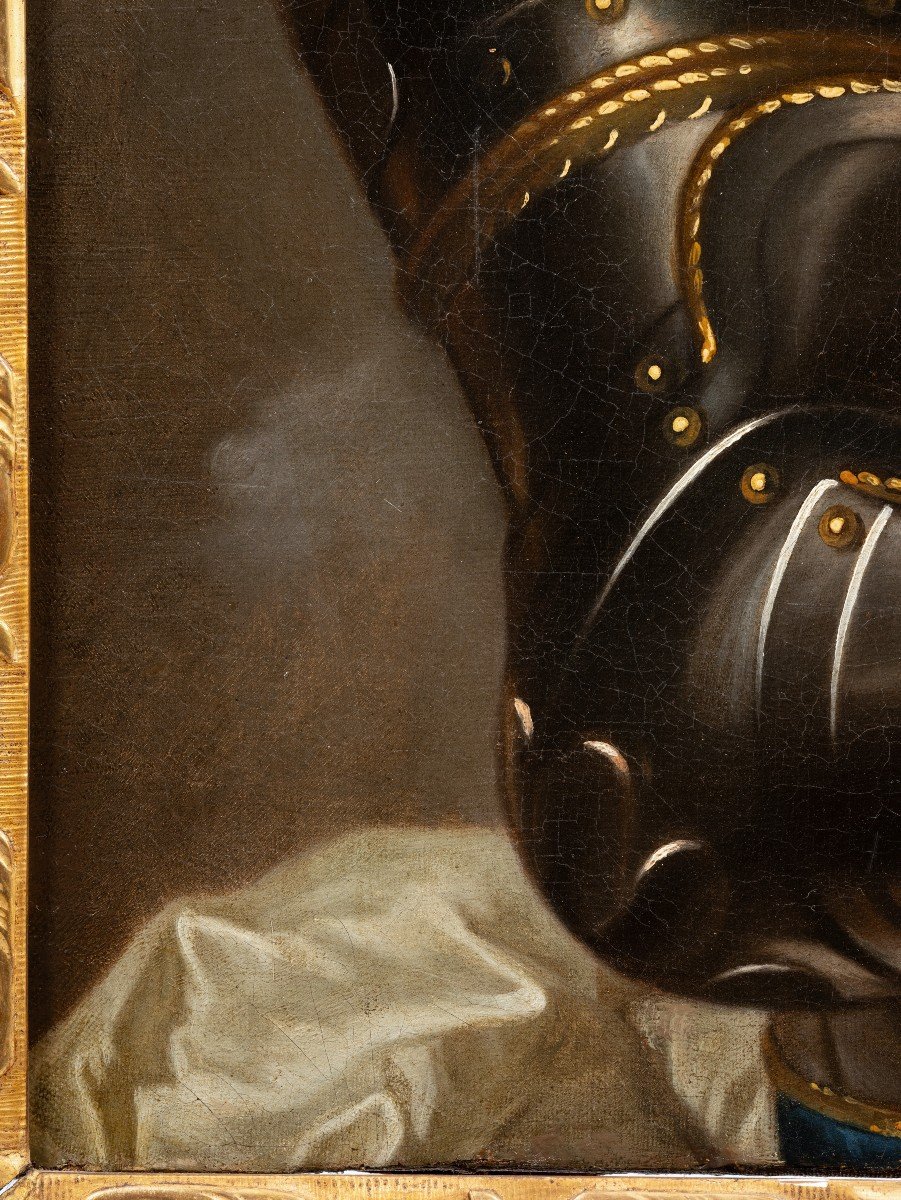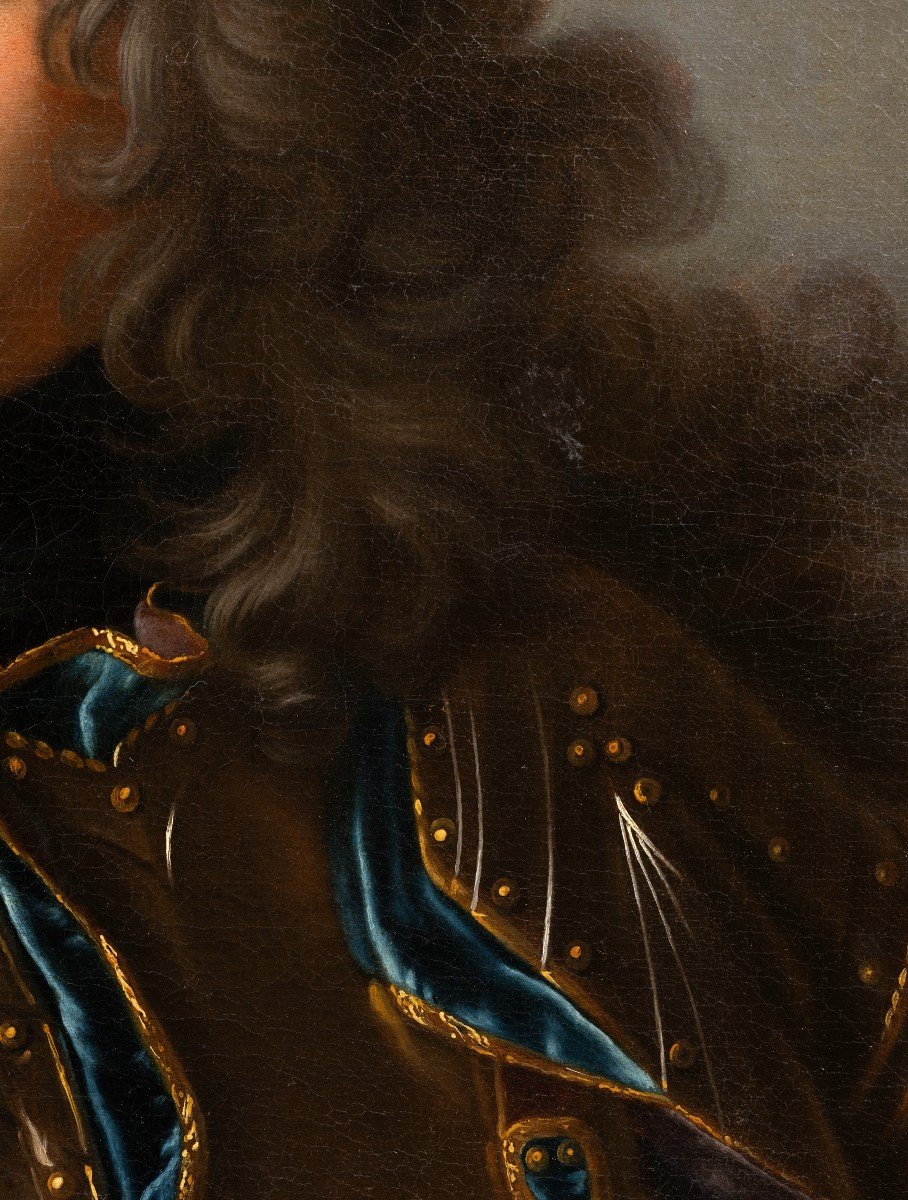Studio of Hyacinthe Rigaud (1659-1743)
Early 18th century French School, circa 1705
OIl on canvas
Dimensions: h. 72 cm, w. 57,5 cm
Louis XIV period gilded and richly carved wood frame with flowered corners.
Framed: h. 96 cm, w. 80 cm
Henri-Louis de la Tour d'Auvergne (1679-1753), Count of Evreux at the age of 24.
The young man is depicted standing, seen at mid-height, turned three-quarters, against a background of a sky filled with cannon smoke.
Head turned to the left, a large wig falling over his shoulders, a youthful face with plain cheeks, a delicate smile from thin lips, a gentle, benevolent facial expression.
The right hand rests on the command staff in the foreground, while the left arm is bent and the hand rests on the hip. He is wearing a white sash of command, the floating drapery of which appears to his right.
Fully armored, his only visible adornments are the blue velvet facings at the joins of the armor pieces and the sleeves of fine white lace.
Power and charisma emanate from this military portrait. The young man's stature, bearing and head carriage convey the image of a valiant warrior.
The theatrical lighting abundantly illuminates the face and creates strong metallic reflections in the armor. Despite his static stance, the hair blowing in the wind enlivens the painting, lending a dynamism and vigor that amplify the model's belligerent attitude.
Our work is a studio version by Hyacinthe Rigaud, the original of which was executed by the artist himself in 1703. This original portrait of the Comte d'Evreux is now housed in the Gemälde Galerie - Alte Meister in the collections of the Kassel Museum.
This portrait, one of the artist's most successful, was exhibited in 1704 at the Salon de l'Académie des Beaux-Arts and received rave reviews. As for the Compte d'Evreux, as soon as the original was created, he was satisfied with the artist's work and directly commissioned several replicas, which were executed by the studio between 1703 and 1705. These studio versions, as in the case of our painting, were intended as gifts from the Count to his wartime companions or members of his family.
Our work is listed in the catalog raisonné of Hyacinthe Rigaud written by the artist's specialist Mr. Stéphane Perreau (see also Mr. Stéphane Perreau's website https://hyacinthe-rigaud.over-blog.com/article-portrait-du-comte-d-evreux-60756307.html).
Provenance: former private collection in Dijon
Henri-Louis de la Tour d'Auvergne, le comte d'Evreux was the fourth son of the Duc de Bouillon, Godefroy-Maurice de La Tour (1641-1721) and Marie-Anne Mancini (1649-1714), niece of Mazarin.
His military career began in 1691, when he was appointed ensign to the king's regiment during the siege of Mons. In 1698, he was promoted to colonel of the Blaisois regiment, and moved steadily up the hierarchy. Brigadier four years later, he was finally promoted to the rank of maréchal de camp in 17042.
In 1707, he married the daughter of a wealthy Paris banker, Marie-Anne Crozat (1696-1729), who brought him a considerable dowry of 2 million livres tournois. The following year, he was made lieutenant-general of the king's armies.
In 1716, he was appointed Governor of Poitou, and in 1719, of Île-de-France4. Between 1718 and 1722, he built a new mansion in Paris, which became his main residence. Known as the Palais de l'Élysée, the residence of the Marquise de Pompadour and Prince Murat, it is now the official residence of the Presidents of the French Republic.
Hyacinthe Rigaud (Perpignan 1659 - Paris 1743)
The most famous portraitist of the reign of Louis XIV.
Born in Perpignan, Rigaud arrived in Paris in 1681. On the advice of Le Brun, he devoted himself to portraiture, a genre he elevated to its highest expression. He was noticed by the King and the Court with his portrait of Monsieur, the Sovereign's brother, in 1688, and of Philippe II d'Orléans the following year. Louis XIV demanded his own portrait in armor, delivered in 1694.
He entered the Académie in 1687, becoming its rector in 1733, after receiving the title of painter to the kings Louis XIV (1694) and Louis XV (1727). A master of ceremonial portraiture, and an admirer of Van Dyck and Rembrandt, he built up a large workshop to satisfy the demands of all the great personalities of his time.































 Le Magazine de PROANTIC
Le Magazine de PROANTIC TRÉSORS Magazine
TRÉSORS Magazine Rivista Artiquariato
Rivista Artiquariato
